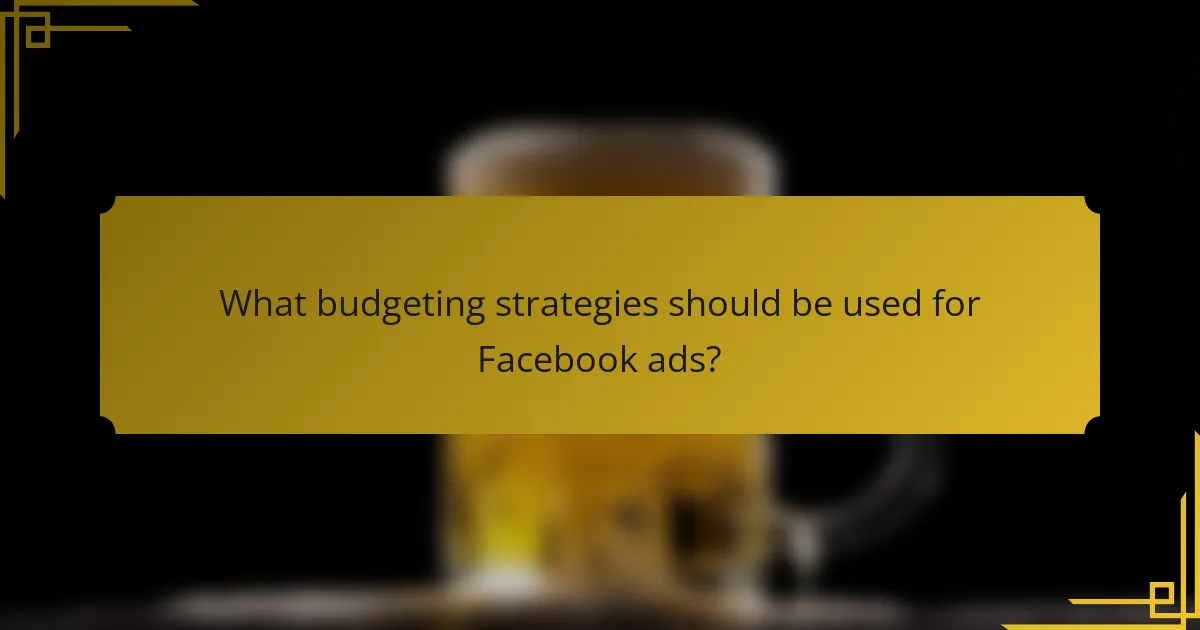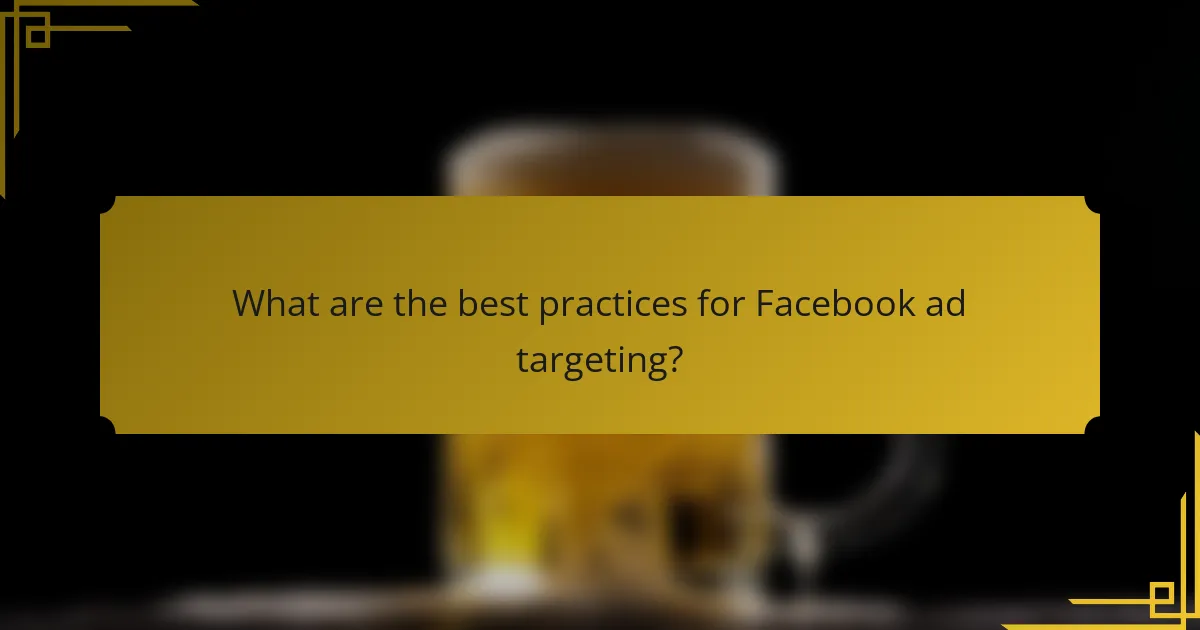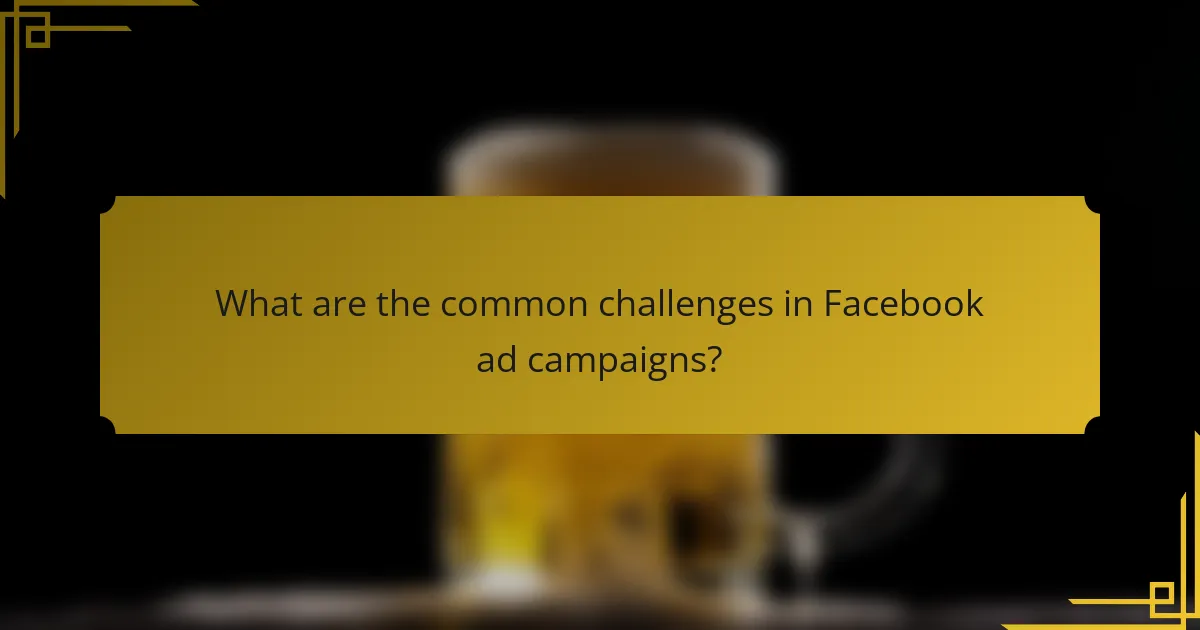Targeted Facebook ads are a powerful tool for reaching specific audiences and maximizing your advertising budget. By defining your ideal audience based on demographics, interests, and behaviors, you can create engaging content that resonates with potential customers. Additionally, effective budgeting strategies, including daily and lifetime budgets, play a crucial role in optimizing ad performance and ensuring a strong return on investment.

How to set up targeted Facebook ads?
Setting up targeted Facebook ads involves defining your audience, selecting ad objectives, and creating engaging content. This process allows you to reach specific demographics effectively, maximizing your advertising budget.
Step-by-step ad creation
To create a Facebook ad, start by accessing the Ads Manager. Click on the “Create” button to begin the ad creation process. Follow the prompts to select your campaign type, ad set, and ad format.
Each step requires specific inputs, such as audience targeting and budget settings. Ensure you review each section carefully to optimize your ad’s performance.
Choosing ad objectives
Your ad objectives should align with your overall marketing goals. Facebook offers various objectives, including brand awareness, lead generation, and conversions. Selecting the right objective helps Facebook optimize your ad delivery.
For example, if your goal is to drive traffic to your website, choose the “Traffic” objective. This choice influences how your ad is shown and to whom, so consider your desired outcome carefully.
Setting up ad placements
Ad placements determine where your ads will appear across Facebook’s platforms, including Instagram and Messenger. You can choose automatic placements for broader reach or manual placements to target specific areas.
Manual placements allow you to select options like Facebook News Feed or Instagram Stories, which can be beneficial depending on your audience’s behavior. Evaluate where your target audience is most active to make informed decisions.
Creating compelling ad content
Compelling ad content is crucial for capturing attention. Use high-quality images or videos and write clear, concise copy that resonates with your audience. Highlight benefits and include a strong call-to-action.
Consider A/B testing different versions of your ad to see which performs better. Monitor engagement metrics to refine your approach and improve future ads.

Who is the ideal audience for Facebook ads?
The ideal audience for Facebook ads consists of users who are most likely to engage with your brand and convert into customers. This audience can be defined by various factors such as demographics, interests, and behaviors.
Defining target demographics
Target demographics include age, gender, location, education, and income level. Understanding these factors helps tailor your ads to specific groups, increasing the likelihood of engagement. For instance, a luxury brand may focus on affluent individuals aged 30-50 in urban areas.
Consider using Facebook’s ad tools to segment your audience based on these demographics. This allows for more precise targeting, ensuring your message reaches those most likely to respond.
Utilizing Facebook Audience Insights
Facebook Audience Insights is a powerful tool that provides data about your potential audience. It offers information on user demographics, page likes, and location, helping you refine your targeting strategy. For example, you can discover that your target audience enjoys specific hobbies or follows certain brands.
Use this data to create ads that resonate with your audience’s interests and preferences. Regularly reviewing Audience Insights can help you adjust your campaigns based on changing user behaviors.
Creating custom audiences
Custom audiences allow you to target specific groups based on your existing customer data. You can upload a list of email addresses or phone numbers to reach users who have already interacted with your brand. This method is effective for retargeting campaigns aimed at converting previous visitors.
Additionally, consider creating lookalike audiences, which target users similar to your existing customers. This expands your reach while maintaining relevance, as these new users are likely to share characteristics with your best customers.

What budgeting strategies should be used for Facebook ads?
Effective budgeting strategies for Facebook ads involve choosing between daily and lifetime budgets, setting appropriate bid strategies, and allocating funds wisely across campaigns. These decisions directly impact ad performance and return on investment.
Daily vs. lifetime budget
When deciding between a daily budget and a lifetime budget, consider your campaign goals and flexibility. A daily budget allows you to control spending on a day-to-day basis, while a lifetime budget spreads your total spend over the entire campaign duration.
For example, if you have a limited budget and want to ensure consistent visibility, a daily budget might be preferable. Conversely, if you are running a time-sensitive promotion, a lifetime budget can help you maximize exposure during peak times without exceeding your overall limit.
Setting bid strategies
Choosing the right bid strategy is crucial for optimizing ad spend. Facebook offers options like cost-per-click (CPC), cost-per-impression (CPM), and cost-per-action (CPA), each suited for different objectives.
For instance, if your goal is to drive traffic to your website, a CPC strategy may yield better results. On the other hand, if brand awareness is your focus, a CPM approach could be more effective. Regularly reviewing performance metrics will help you adjust your strategy as needed.
Allocating budget across campaigns
Effective budget allocation across campaigns requires understanding which ads perform best. Start by analyzing past campaign performance to identify high-performing ads that warrant more investment.
A common approach is to allocate a larger portion of your budget to campaigns with proven success while maintaining a smaller budget for testing new strategies. This way, you can optimize your overall ad spend and ensure that resources are directed toward the most effective campaigns.

What are the best practices for Facebook ad targeting?
Effective Facebook ad targeting involves understanding your audience and utilizing various strategies to reach them efficiently. Best practices include leveraging data-driven insights, refining audience segments, and continuously optimizing campaigns based on performance metrics.
Using lookalike audiences
Lookalike audiences allow you to target users who share similar characteristics with your existing customers. By uploading a list of your current customers or using Facebook’s pixel data, you can create a new audience that mirrors their demographics and behaviors.
To maximize effectiveness, ensure your source audience is well-defined and consists of high-value customers. This way, the lookalike audience is more likely to convert, improving your return on ad spend (ROAS).
Retargeting previous visitors
Retargeting focuses on users who have previously interacted with your website or app but did not convert. By showing ads to these individuals, you can remind them of your offerings and encourage them to return and complete a purchase.
Implementing retargeting campaigns can significantly boost conversion rates, often yielding higher engagement than standard ads. Consider segmenting your retargeting audience based on their behavior, such as pages visited or time spent on the site, to tailor your messaging effectively.
Segmenting audiences for better performance
Segmenting your audience involves dividing them into smaller groups based on specific criteria like demographics, interests, or behaviors. This practice allows for more personalized ad content, which can lead to improved engagement and conversion rates.
When segmenting, consider factors such as age, location, and purchasing behavior. For instance, targeting younger audiences with trendy products while promoting value-driven items to older demographics can enhance relevance and performance. Regularly review and adjust your segments based on campaign results to ensure optimal targeting.

How to measure the success of Facebook ads?
Measuring the success of Facebook ads involves analyzing various metrics to determine their effectiveness in achieving your marketing goals. Key indicators such as engagement rates, conversion rates, and return on ad spend (ROAS) provide insights into how well your ads are performing.
Key performance indicators (KPIs)
Key performance indicators (KPIs) are essential metrics that help evaluate the success of your Facebook ads. Common KPIs include click-through rate (CTR), conversion rate, and cost per acquisition (CPA). Tracking these metrics allows you to understand user engagement and the overall effectiveness of your campaigns.
For instance, a high CTR indicates that your ad is compelling to your audience, while a low CPA suggests efficient spending on acquiring customers. Aim for a CTR of around 1-2% for most industries, but adjust expectations based on your specific market and objectives.
Using Facebook Ads Manager for analytics
Facebook Ads Manager is a powerful tool for analyzing your ad performance. It provides detailed reports on various metrics, allowing you to view data by campaign, ad set, or individual ad. Utilize the dashboard to monitor KPIs and gain insights into audience behavior and ad effectiveness.
To get started, navigate to the “Ads Reporting” section, where you can customize reports to focus on the metrics that matter most to your business. Regularly reviewing this data will help you make informed decisions about your advertising strategy.
Adjusting campaigns based on performance data
Adjusting your Facebook ad campaigns based on performance data is crucial for optimizing results. If certain ads are underperforming, consider modifying the ad copy, visuals, or targeting options. A/B testing different elements can also provide insights into what resonates best with your audience.
Set a regular schedule to review performance data, such as weekly or bi-weekly, and be prepared to make adjustments quickly. For example, if an ad has a low conversion rate, reallocating budget to higher-performing ads can improve overall campaign effectiveness.

What are the common challenges in Facebook ad campaigns?
Facebook ad campaigns often face challenges such as ad fatigue, audience saturation, and budget management. These issues can hinder performance and lead to wasted resources if not addressed effectively.
Ad fatigue and audience saturation
Ad fatigue occurs when users see the same ad too frequently, leading to decreased engagement and effectiveness. Audience saturation happens when the same audience is targeted repeatedly, resulting in diminishing returns on ad spend.
To combat ad fatigue, regularly refresh your creatives and copy. Consider rotating ads every few weeks or introducing new visuals to maintain user interest. For audience saturation, expand your targeting options by including lookalike audiences or interest-based segments to reach new potential customers.
Avoid overexposing your audience to the same message. Monitor engagement metrics closely; if click-through rates drop significantly, it may be time to adjust your strategy. Testing different ad formats, such as carousel or video ads, can also help keep your content fresh and engaging.
